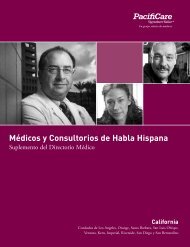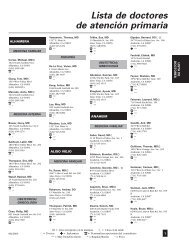CALIFORNIA - Pacificare Health Systems
CALIFORNIA - Pacificare Health Systems
CALIFORNIA - Pacificare Health Systems
You also want an ePaper? Increase the reach of your titles
YUMPU automatically turns print PDFs into web optimized ePapers that Google loves.
PART A<br />
130<br />
Definitions<br />
i. Treating Physician means a Physician who has<br />
personally evaluated the patient.<br />
ii. A health intervention is an item or service<br />
delivered or undertaken primarily to treat (that<br />
is, prevent, diagnose, detect, treat or palliate)<br />
a medical condition or to maintain or restore<br />
functional ability. A medical condition is a<br />
disease, illness, injury, genetic or congenital<br />
defect, pregnancy or a biological or psychological<br />
condition that lies outside the range of<br />
normal, age-appropriate human variation.<br />
A health intervention is defined not only by<br />
the intervention itself but also by the medical<br />
condition and the patient indications for which it<br />
is being applied.<br />
iii. Effective means that the intervention can<br />
reasonably be expected to produce the intended<br />
results and to have expected benefits that<br />
outweigh potential harmful effects.<br />
iv. <strong>Health</strong> outcomes are outcomes that affect health<br />
status as measured by the length or quality<br />
(primarily as perceived by the patient) of a<br />
person’s life.<br />
v. Scientific evidence consists primarily of controlled<br />
clinical trials that either directly or indirectly<br />
demonstrate the effect of the intervention on<br />
health outcomes. If controlled clinical trials are<br />
not available, observational studies that suggest<br />
a causal relationship between the intervention<br />
and health outcomes can be used. Partially<br />
controlled observational studies and uncontrolled<br />
clinical series may be suggestive but do not by<br />
themselves demonstrate a causal relationship<br />
unless the magnitude of the effect observed<br />
exceeds anything that could be explained either<br />
by the natural history of the medical condition<br />
or potential experimental biases. For existing<br />
interventions, the scientific evidence should<br />
be considered first and, to the greatest extent<br />
possible, should be the basis for determinations<br />
of Medical Necessity. If no scientific evidence is<br />
available, professional standards of care should<br />
be considered. If professional standards of care<br />
do not exist or are outdated or contradictory,<br />
decisions about existing interventions should<br />
be based on expert opinion. Giving priority to<br />
scientific evidence does not mean that coverage<br />
of existing interventions should be denied in the<br />
absence of conclusive scientific evidence.<br />
Existing interventions can meet the definition<br />
of Medical Necessity in the absence of scientific<br />
evidence if there is a strong conviction of<br />
effectiveness and benefit expressed through upto-date<br />
and consistent professional standards<br />
of care or, in the absence of such standards,<br />
convincing expert opinion.<br />
vi. A new intervention is one that is not yet in<br />
widespread use for the medical condition and<br />
patient indications being considered. New<br />
interventions for which clinical trials have not<br />
been conducted because of epidemiological<br />
reasons (i.e., rare or new diseases or orphan<br />
populations) shall be evaluated on the basis of<br />
professional standards of care. If professional<br />
standards of care do not exist, or are outdated<br />
or contradictory, decisions about such new<br />
interventions should be based on convincing<br />
expert opinion.<br />
vii. An intervention is considered cost-effective if the<br />
benefits and harms relative to costs represent<br />
an economically efficient use of resources for<br />
patients with this condition.<br />
In the application of this criterion to an individual<br />
case, the characteristics of the individual patient shall<br />
be determinative.<br />
Medicare (Original Medicare) – The Hospital<br />
Insurance Plan (Part A) and the supplementary Medical<br />
Insurance Plan (Part B) provided under Title XVIII of<br />
the Social Security Act, as amended.<br />
Medicare Eligible – Those Members who meet<br />
eligibility requirements under Title XVIII of the Social<br />
Security Act, as amended.<br />
Member – The Subscriber or any Dependent who is<br />
eligible, enrolled and covered by PacifiCare.<br />
Mental Retardation and Related Conditions – An<br />
individual is determined to have mental retardation<br />
based on the following three criteria: Intellectual<br />
functioning level (IQ) is below 70-75, significant<br />
limitations exist in two or more adaptive skill areas,<br />
and the condition is present from childhood (defined<br />
as age 18 or less).<br />
National Preferred Transplant Network Facility – A<br />
network of transplant Facilities that are:








